Note: Don’t forget to grab the free Beastly Launch Blueprintat the end of this post.
The first time I came across Ramit Sethi’s website, I rolled my eyes.
IWillTeachYouToBeRich.com…seriously? Who the hell is this guy?
But I’d heard good things from people I trusted…
“This guy really knows how to do content.”
“His emails are incredible.”
“He’s like a cool version of Dave Ramsey who lets you still have fun.”
So I subscribed to Ramit’s email list after several recommendations over a year before writing this post. Here’s the deal:
- All those good things I heard were completely true.
- His free content is so good that I feel like I’ve already learned a few course worth’s of information…and I’ve never even bought anything (yeah, I’m a cheap SOB, I know).
- The series of 23 (!) emails he just sent to launch his latest online course (not an affiliate link) is one of the best pieces of content, copywriting, and email marketing I’ve seen in a long time.
In this post, I’m going to show exactly what made Ramit’s 23-email launch sequence great and how you can apply the techniques he used to your business.
Important Note: I’m not recommending you immediately try implementing ALL of Ramit’s strategies into your marketing efforts. He has years of practice under his belt, a dedicated team, and vast resources. So look it over, pick two or three strategies that you can quickly implement, and test them. Even if you only do 10% of what Ramit did, you’d still be doing more than most people are willing to do.
First, let’s take a look at the timeline and phases of Ramit’s launch: 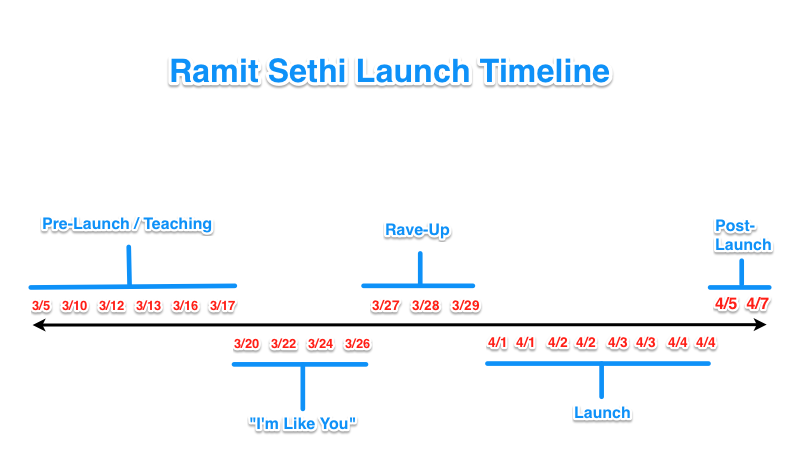 23 emails sent out over a period of one month, two days. Ready to break this down? Me too.
23 emails sent out over a period of one month, two days. Ready to break this down? Me too.
Phase #1: Pre-Launch / Teaching Phase (6 Emails)
This Pre-Launch / Teaching phase is all about two things:
- Being 100% transparent that there’s a major product launch coming up.
- Delivering relevant content so good that the impending deluge of emails won’t bother readers as much—they’ll be too excited to read them to care they’re being sold something.
But before Ramit gets straight into the meaty, course-related free content, he does two other important things with the very first email:
- He builds curiosity.
- He shows you the result before showing you the process.
Here’s how he accomplishes those two elements, and why they can be such valuable parts of any launch.
Building Curiosity
The curiosity all starts with the subject line:
Subject: The #1 most requested topic on IWT
If you’re a reader, obviously this will be of interest to you. (And trust me, Ramit writes for his readers first and foremost—note the usage of the IWT acronym, which a newer reader might not recognize as an abbreviated acronym for I Will Teach You To Be Rich.)
He then builds on the curiosity in the subject line with a little story about a last-minute ski trip he’s about to take with friends.
The next phase of curiosity? Interaction. Ramit gives readers something to do by asking for their best guesses at what the #1 most requested topic actually is.
He doesn’t come out and reveal it completely, instead leaving you with the following hint:
Here’s a hint:
I decided to take the weekend trip yesterday (Tuesday). I built a lifestyle that lets me travel on a flexible schedule. And while I’m traveling — while I’m flying, and while I’m skiing — my business will generate enough to revenue to pay for the trip many times over.
Anybody curious?
Talk to you Monday morning.
This hint keeps building the curiosity, but it’s also part of the second element I mentioned earlier, which we’ll now look at in more detail.
Showing the Result Before the Process
No one really wants to work out a bunch and eat healthy. They just want a six-pack.
No one really wants to confront their fears. They just don’t want to be afraid anymore.
No one really wants to put in the work to build an online business. They just want more freedom and flexibility.
And that’s the exact picture Ramit paints with this email. But he doesn’t just describe what his life looks like; he shows you with the email screenshot he includes:
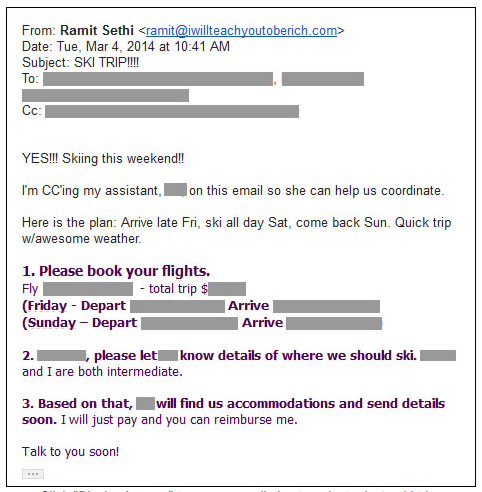
Ramit spends the rest of the email explaining that this topic is going to show you how to create that same lifestyle for yourself.
Because before people want to hear about the process you can teach them, they want to hear about the results of the process.
The Rest of the Pre-Launch / Teaching Phase:
This phase contains five more emails:
- “Straight truth about starting an online business” (in which he reveals the “process” part of the equation, building an online business)
- “Business ideas: Which online business should you start?”
- “Online business: From my first sale to a $12,000 product”
- “The 3 best posts I wrote last week (from Ramit)”
- “The Zig/Zag Technique to finding an online business idea”
These emails make up over 4,000 of the words within this 17,000-word sequence, and they accomplish a variety of things—particularly, they help readers overcome their initial objections like:
“Why should I listen to you about building an online business, Ramit?”
From Email #2:
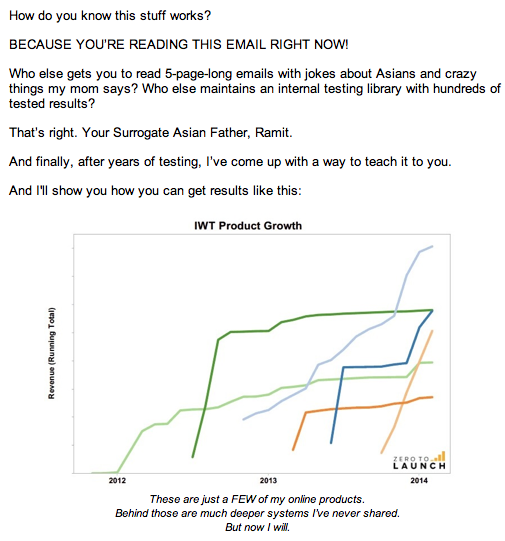
“What makes this different from all the other online business crap out there?”
Ramit does a great job of sprinkling great lines and short paragraphs throughout Emails #2, 3, and 4 that answer this objection. Things like:
“Unlike the unscrupulous marketers whose entire business is creating ebooks about creating ebooks, I’ve spent years teaching core topics of personal finance, careers, negotiation, and psychology.”
“Ebooks about creating ebooks” – people are getting so sick of stuff like that!
“We’re not going to pray to the passive income gods and sell a $17 ebook and wait 9 months to earn $15.39. (If you want, I’ll share real stories of the passive income crowd — and how much they really earn — that will blow your mind.)”
Who else can’t wait to hear those “real stories”?
“We move fast and we move aggressively. If you don’t like that, sorry, but I refuse to pander to the lowest common denominator and give you BS advice that makes you feel good (but produces no measurable results).”
This helps weed out the people who aren’t willing to do the work the course requires.
“What other “experts” teach:
1. Find your passion
2. ???
3. Profit!
“Unlike other gurus who will tell you to follow your passion (then leave out step #2 and skip right to you somehow ending up living the dream lifestyle), I take a very different approach.”
This really speaks to people who have been burned by courses that offer inspiration but no practical steps.
“I’d love to start an online business, but I don’t have an idea for one!”
“I’m not sure what kind of product to create.”
Ramit uses Emails #3 and #4 + a meaty blog post to help readers through both of these objections, and in the first line of Email #3 he lets you know right away that he’s about to do so:
“By the end of this email, you’ll know exactly what kind of online business to start.”
Who’s not going to read at least just to see if he delivers on that promise?
“Okay, I have an idea…but how do I stand out from others already doing the same thing?”
In Email #6, Ramit reveals what he calls his “Zig/Zag Technique,” which explains the psychology behind differentiation. He doesn’t just tell you his course will show you how to stand out; he actually teaches you in the email how to start standing out right away…without even buying the course.
Important Note: Ramit throws an extra psychological trigger into the email copy for Email #6—he doesn’t just teach you how to differentiate for free; he specifically points out that he’s teaching you stuff for free instead of just selling. He says:
“Have you noticed how excited people are to finally hear me talking about creating an online business? I could open Zero to Launch tomorrow and a ton of people would join. But I’m in the enviable position of not needing to make a quick buck — which means I can take my time showing you the nuances of how powerful an online business can be before I ever open a premium course.”
To some, this will come off as bragging. But to the people who are really interested, this says, “Hey, I actually give a crap about you and want you to get real results out of this!”
Tip: Before you start writing copy for any launch sequence, write out every objection your ideal customer might have. Make sure your copy addresses those objections.
By now, you may have noticed a pattern. We’re only six emails in and Ramit has already bent over backwards to actually create content that teaches things of value (hence the aptly named “Pre-Launch / Teaching Phase”).
You also may have noticed something else—this guy is not shy about discussing how rich and successful he is. Which begs the question…how are people who are just starting out supposed to relate to him? How are they supposed to believe they can achieve the same results?
Enter the “‘I’m Like You’ Phase” (the phase of Ramit’s launch sequence that I personally find to be the most subtly brilliant).
Phase #2: “I’m Like You” Phase (4 Emails)
If you think this phase is just a bunch of lame “I was once just like you” stories, think again. Ramit is all about zagging while everyone else zigs, which is why this phase is:
- Way subtler than most people’s attempts at relating to their audience
- Funny
- Genuine
So how does Ramit kick off this phase I’ve described as “subtly brilliant”? With Miley Cyrus, of course.
Here’s the opening line from the first email in this phase, Email #7:
“You’re about to get advice from a guy who was recently listening to Pandora, heard an awesome song come on, loved it enough to search for the lyrics, and paused when he realized it was by Miley Cyrus. Then he (I) added it to his playlist.”

(Yes. That’s the picture he used in the email.)
Obviously, this is a funny and unconventional way for him to kick off this email. But here’s the real brilliance—he just related to you in a way that has absolutely nothing to do with the product.
It wasn’t another “I was just as unsuccessful as you when I started my first online business” stories. Everyone’s heard those stories. Know why? Because everyone selling an online product HAS those stories and they never shut up about them! It’s gotten to the point where prospects are almost numb to them.
Tip: Sometimes the best ways to relate to your readers/prospects are in the little, everyday ways (I call these the “Seinfeld-esque” moments). Make it easy to see that you’re a real person. Relate to them in ways beyond the professional sense.
In Email #8, “Rico Suave recap of this week’s posts,” he previews what he’ll be writing about in the next week. On the subject of “How to Conquer Fear,” he writes:
“I wasn’t always the dashing man with enviable eyebrows you now know. How do you know when you’re ready to start an online business? What if you’re not an expert? And why would anyone pay attention to you?”
He accompanies those lines with the following incriminating photo from 2002:

He brings the embarrassment full circle to the present day with Email #10, “I fell down at the bowling alley,” about—yup, you guessed it—falling down at the bowling alley.
The email consists of four sentences and a link to a six-second video of Ramit falling down at the bowling alley.
Need I say more? Sometimes you don’t need to overthink relating to your audience.
So What’s the Point of the “I’m Like You” Phase?
Look, if you’re going to write a 17,000 word launch sequence and send your audience 20+ emails in a single month…there’s one critical ingredient that must be there:
They have to freakin’ LIKE you. A lot.
Value goes a long way. But, in case you haven’t noticed, people have been stepping up their online content game lately. More and more people and companies are realizing how valuable good content is, and they’re investing tons of money in it.
That’s not to say that truly great content is right around every corner, because it’s not. But I am saying that giving away great free content isn’t the end-all, be-all key to being unique.
Nope. The key to being unique is about the same thing it’s always been about—personality.
So feel free to tell us about the embarrassing song you accidentally liked. Show us that you didn’t always wear custom-tailored suits. And don’t let your friends hog the embarrassing videos of you making an ass of yourself at the bowling alley.
By the way, if you’re ever feeling bad about yourself, just look at this picture of me circa 2007 and know it can’t get much worse.

Phase #3: Pre-Launch Rave-Up (3 Emails)
The above picture was taken when I was 18 (!) years old, and much cooler than I am now. At the time, I was playing bass for a pretty awesome band called The Dirty Holidays. Everyone in the band was way more talented than me, but somehow I snuck in and stuck around for a good five years.

One day in practice, the term “rave up” started getting thrown around, as in, “Hey, in the second verse we should do kind of a rave up before the chorus.”
I kind of knew what it meant, but I wanted to make sure. So after practice, I Googled it and found this:
“‘Rave up’ was a term used to describe a musical arrangement, usually during the middle instrumental section of a song, when the beat shifts into double-time and the instrumental improvisation gradually builds to a climax.”
And that’s exactly what Phase 3 is all about—speeding things up as the launch builds to its climax.
In Phases 1 and 2, Ramit sent an email every other day, with a couple back-to-back days sprinkled throughout. In Phase 3, however, he blasts out three emails in a three-day period.
Why? To break up the pattern he’s created and remind you that something very big is about to happen. To prepare you to receive two emails per day, the frequency during the upcoming Launch Phase.
But it’s not just about frequency. It’s also about content medium. These three emails are all specifically designed to get you to register for two live webinars about specific concepts related to the Zero to Launch course.
You might be thinking, Geez, isn’t 17,000 words of emails, plus several additional blog posts and videos enough content? Why go to the additional trouble to do webinars?
Because it’s yet another content medium.
In case you haven’t noticed, Ramit released just about every form of online content you can create for this launch. He did emails, blog posts, videos, PDFs, case studies, interviews, and webinars.
The reason he went to all this trouble is simple—different people prefer consuming content in different ways. Just because some subscribers won’t read a 2,000-word email doesn’t mean they won’t attend two webinars in a 48-hour period, and vice versa.
Tip: The more ways you allow people to consume your content, the more people you will reach.
Don’t forget—launches are, at their core, events. And there’s no online content medium more event-based than the live webinar.
Phase #4: Launch Phase (8 Emails)
Ramit’s launch phase started the day you could officially buy the course (April 1) and extended four days at a rate of two emails per day.
Here’s the interesting thing that happens with anytime you get down the actual launch of the course—you start dealing with an entirely new set of objections.
See, up to this point, Ramit was convincing readers they could start a successful online business and that he is the guy to show them how.
For some buyers, that’s all it’s going to take. In fact, Ramit mentions many times the large number of people who were already contacting him asking to buy after only the first couple of emails.
However, many others are going to have all sorts of new/recurring objections when that cart finally opens and they see the price. Things like:
- Am I sure this is right for me?
- I’m scared. Can I really do this?
- What if the course actually sucks?
- I really want to buy this, but I just can’t afford it right now.
- I need to talk to someone else who’s actually been through the course before I buy it.
Here’s how Ramit handled those objections in the Launch phase:
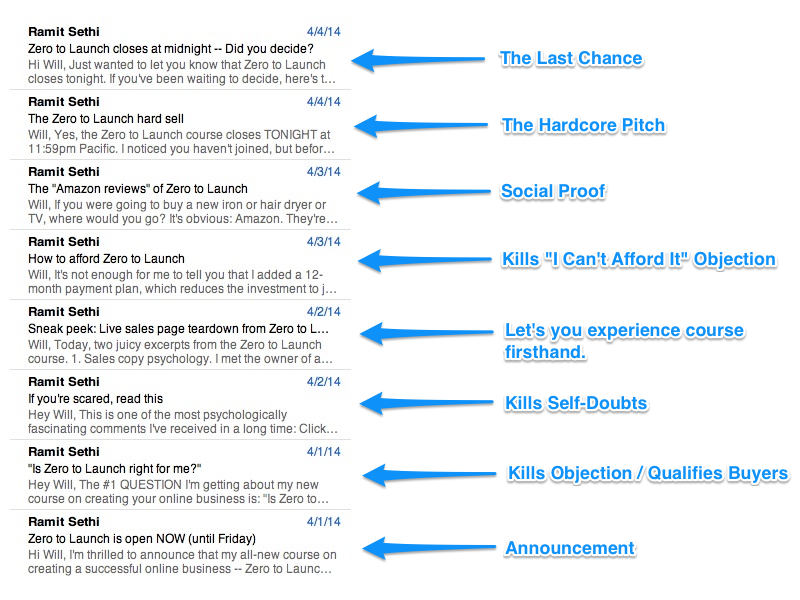
Phase #5: Post-Launch Phase (2 Emails)
Hint: People who do not buy your product are not immediately useless to you. They actually present two huge opportunities, and Ramit took advantage of both of them.
Opportunity #1: Identify the people who didn’t buy this time but want to at some point.
It’s fine to be strict if you’re giving people a “cart closed” deadline. In fact, if you create a habit of letting people purchase after deadlines, you’ll end up damaging any future sense of urgency you try to create.
But just because you say, “No, you missed the deadline and you can’t buy it now,” doesn’t mean you need to turn away warm prospects forever. Instead, do what Ramit did and offer them the opportunity to grab a spot on your “waitlist:”
“If some openings come up, I’m opening a small waitlist for Zero to Launch. I’ll let people on this waitlist — and no one else — know about them. If you’re still interested in starting an online business, add your name to the Zero to Launch waitlist.”
That way, you’re able to keep a list of people who you know are super-warm, ready-to-buy prospects.
Opportunity #2: Learn from those who didn’t buy.
This is a huge opportunity most people overlook…and it’s so simple to do.
When your launch is done, simply link to a quick survey in the P.S. of the next email you send your list. This is all it takes:
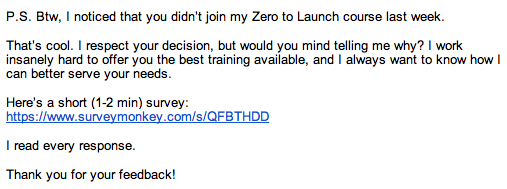
This allows you the chance to get quality answers to all sorts of questions, like:
- Were you considering joining the program, or not considering at all?
- In your own words, why didn’t you join the program?
- Which of the following factors played a role in your decision? (Insert multiple choice list of possible factors.)
- If you were interested but didn’t join, what will you do about [INSERT COURSE TOPIC HERE] instead? Why?
- If I could create ANY course for you, what would it be?
(Those are the questions Ramit asked, by the way. And it’s pretty easy to see how useful the responses could be.)
Here’s my favorite thing about that survey email though. The survey was put in the P.S. of an email that came post-launch, and had seemingly nothing to do with the launch. It was “back to normal” content.
Seemingly…until you dig a little deeper.
The subject line was “Examples of spending on the things you LOVE?” In the email, Ramit discusses a Reddit thread where people shared their most extravagant discretionary expenses. He then invites readers to leave comments sharing their biggest discretionary expenses.
He says:
“So today, I thought it would be interesting to share our BIGGEST discretionary expense. No guilt. No shame. Just an interesting look into the spending patterns of people who are committed to living rich lives — whatever that means to you.”
Hmmmm. Let’s follow the series of events, here.
Ramit launches $2,000 course –> Ramit creates waitlist for people who want to buy next time –> Ramit gets readers to think about the biggest things they buy that they don’t truly need –> Ramit asks non-buyers why they didn’t buy the course.
Is this intentional? I can’t know for sure. But yes, it was intentional. And it was a brilliant way to wrap up the first launch of Zero to Launch.
Get the Beastly Launch Blueprint:
So here’s the deal. I’d love to put all 23 of Ramit’s emails into a PDF for you to download, but since they’re not mine, that just didn’t feel right.
However, I did create my own personal notes on the overarching strategy I noticed while studying the launch. Consider it the generic blueprint you can take and apply to anything you plan on releasing soon. I made them presentable and organized them into a downloadable PDF for you. 🙂
Just click here to grab your copy now.
And tell me in the comments…which of Ramit’s strategies do you plan on implementing, and how?
